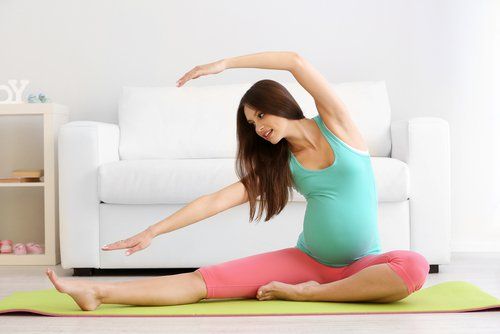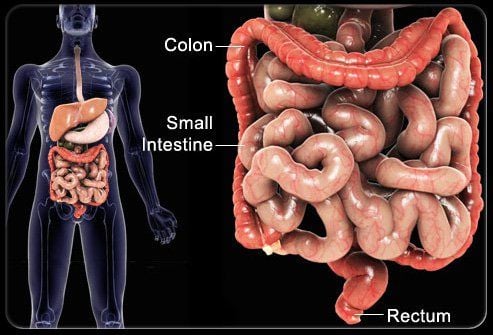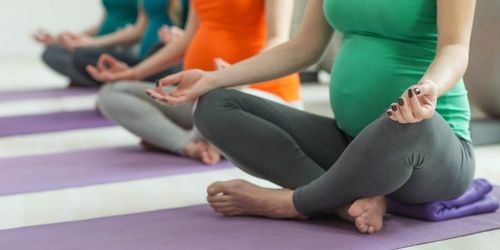This is an automatically translated article.
Article by Bachelor's Degree - Meditation - Yoga Specialist - Unit of Regenerative Medicine Clinic and Educational Psychology - Center of Regenerative Medicine and Cell Therapy at Vinmec Times International General Hospital City.
For pregnant mothers, in the first trimester, there are people who feel little change in their body, there are mothers who feel very clearly difficulties such as morning sickness, nausea, dizziness, Insomnia...the first trimester is also the period most likely to lead to miscarriage, so exercise during this period seems to be limited to the maximum to avoid affecting the fetus. However, limiting excessive movement or sitting (lying) in one position for too long will also adversely affect the health of the pregnant mother and baby, so choosing the right yoga movements and Gentle practice will help pregnant women better understand the changes in the body by combining breathing and movements, eliminating the discomfort of the first trimester and the ability to bond between mother and baby through movements. yoga practice.
1. Yoga benefits of the first trimester.
In the first trimester, most pregnant women experience dizziness, nausea and loss of appetite. Some pregnant women, due to limited mobility and little exposure to the outside environment, may feel unstable, sometimes falling into a state of boredom, sluggishness, and discomfort. Therefore, the pregnant mother's gentle exercise and proper yoga practice in the first trimester not only helps the pregnant mother restore energy faster, balance her health, yoga in the first 3 months of pregnancy also supports well. In the metabolism between mother and baby, helping to connect mother and child
When familiar with correct breathing and appropriate yoga exercises, pregnant mothers will feel joyful, happy, and sleep is improved , weight is controlled during pregnancy, easy to get back in shape after giving birth.
Being familiar with breathing exercises and yoga exercises during pregnancy in the first months of pregnancy is also a good habit to help the pregnant mother's body become more supple, minimize back pain, cramps, and aches in the body. last month of pregnancy. In addition, nutrition and regular check-ups will definitely help pregnant women have a healthy and safe pregnancy.
2. The risks and warnings that pregnant women in the first trimester need to know
Pregnant women choose safe, gentle exercises, and practice 30 minutes a day, preferably once in a while for a long time. About 10-15 minutes after the training session, you should drink liquid food and drink liquid, after 30 minutes you should eat solid food. However, pregnant women should not let their body get too thirsty, can drink a small sip of water when feeling thirsty during exercise.
Pregnant women should skip head and shoulder exercises, pregnancy is not the time to start exercises with inversion, because the risk of falling or fainting is very high. The reason is that when the head is lowered, the position of the head is lower than the heart, so it is not safe for most pregnant women.
When practicing yoga, pregnant women should listen to their body, avoid exertion and posture beyond their experience and ability. If pregnant women have any problems, no matter how small, causing them pain, they need to stop and contact a doctor.
Always warm up before starting and cool down after finishing the workout.
Yoga exercises should be for pregnant women who are healthy and have no problems with pregnancy such as: pregnancy poisoning, threatened miscarriage, high - low blood pressure, a history of premature birth, pregnant mothers performing IVF. ..should only do gentle exercises such as breathing, relaxing safely for pregnant women, helping pregnant women feel secure and calm during pregnancy
3. Breathing exercises, warm up and warm up the body.
3.1 Breathing exercises Breathing exercises during pregnancy are very important for pregnant women. Proper breathing helps increase the amount of oxygen to meet the growing needs of the fetus as well as optimize the functions of the pregnant mother's body. However, breathing is only really effective when pregnant women practice breathing skills properly. Some breathing exercises below are said to be the simplest and most effective for mothers who are in the first trimester
Deep breathing : In the early stages of pregnancy, feeling tired and nausea occurs often When you often stop your activity, that's when you need to practice breathing deeply and in moderation.
How to practice breathing for this stage is as follows:
Take a deep breath to fill your lungs and exhale. Focus your energy by focusing on one point such as the ceiling, wall or floor... The feeling of discomfort in the body begins to take place: take a deep breath 5-10 times / minute. As you inhale, place your hand on your lower abdomen and gently stroke it toward your ribs. As you exhale, stroke your hands from the side down towards the lower abdomen. Belly breathing: Belly breathing is a popular and easy-to-practice exercise with many health experts recommending pregnant women to practice. There are 2 positions for pregnant women to do this exercise:
Sitting position:
Sit in a comfortable position, legs folded. Relax your entire body including your jaw, back and hips. Place one hand under your stomach and one above your stomach, then breathe deeply from your lower abdomen to take in as much air as you can. Count from 1 to 8 while inhaling and, or you can count any number as long as you feel comfortable. Next, exhale gently, counting the number as the previous inhalation. Repeat these 2 inhalations and exhalations for at least 10 minutes every day until you feel this exercise easier.
Lying position:
Start with a supine position, upright (should use a pillow to support the head). Bend your knees so that the soles of your feet touch the floor and your arms are relaxed with your body, down to your feet. Then, practice inhaling and breathing deeply like a sitting position.
3.2 Warm-up exercises for pregnant women Warm-up is something that all coaches recommend to do when participating in any subject. So you understand the importance of warm-up exercises, as well as how to do it right?
Why boot?
Warm-up helps both physically and mentally prepare the practitioner. Thereby reducing the risk of injury and pain after exercise.
When warming up, the amount of oxygen to the muscles is gradually added. As more blood reaches the muscles, tendons and ligaments, they become more elastic. This will easily make the stretching process easier and more effective.
The warm-up movements help the heart rate increase gradually, not too suddenly causing harm to the cardiovascular system. Blood is also easily circulated better. This will help the muscles and connective tissue become more flexible during exercise.
Neck warm-up exercise.
Step 1: Press your chin into the hollow of your neck, inhale slowly tilt your neck back, exhale back to the original position (5 times).
Step 2: Inhale slowly turn your face 90 degrees to the left, exhale to return to a straight position, continue to inhale and turn your face to the right 90 degrees then exhale back to the original position (5 times)
Step 3: Inhale slowly tilt your head to the left, exhale back to the starting position (5 times).
Step 4: tilt your neck back to the fullest, then shake it to both sides gently, half a circle at the back of your neck.
Shoulder and full arm warm-up exercise.
Step 1: Bring your hands to the level of your palms, slowly bend your elbows so that your fingertips touch your shoulders. I put my hands out in front of my face, slowly inhale, bring my hands up close to my ears, exhale, open my shoulders and gradually press down to my ribs. Continue doing this 5 times.
Step 2: Do the opposite, slowly press your hands down to your ribs while inhaling, bring your shoulders back up, gradually close to your ears, then bring your hands forward and exhale (5 times)
Step 3: Warm-up elbows: we open our hands to the horizontal, palms up, slowly bend the elbows into the ribcage, bring them down and then return to the original position. Repeat 5 times and vice versa.
Step 4: Warm up the wrist
Bend the hand perpendicular to the arm, slowly open the wrist back so that the hand is perpendicular to the arm, palm facing out. Slowly bend your wrist under your palm facing in, and then bend your wrist back to the starting position. Slowly bend your wrist forward perpendicular to your arm, palm facing out. Slowly bend your wrists down, palms facing in, and then bend your wrists back to the starting position. Do it 3-5 times.
Step 5: Warm up the fingers.
Slowly grasp the hand folded perpendicularly downwards. Bend your wrists perpendicularly upwards. Release the hand with the fingers folded in half, the hand perpendicular to the arm. Slowly stretch all fingers to the sides, hold for 3 seconds. Gradually release all the fingers and continue to do 3-5 times.
Warm-up exercise:
Sitting ankle rotation: put your left foot on your right thigh, rotate your ankle 30 times, and switch sides. Rotate your knees with your hands behind you, lift each leg up and rotate your knees. Do the same on the other side.
Warm-up exercises for hip joints:
Sit with your legs extended forward, the soles of your feet facing each other, and bend your legs to squeeze your feet to the side of the body. The two legs vibrate slightly, flap their feet to the rhythm of the butterfly's wings, perform 5-10 beats of the foot.
Back and side exercises:
Sit comfortably, inhale with both arms raised, exhale, lower your arms, turn your body slightly to the right, repeat 3 times and then switch sides. In this position, the pregnant mother should pay attention not to twist the ribs too hard, to avoid affecting the fetus.
Still in that position, inhale, stretch your arms high, slightly tilt your head back, exhale, bend forward slightly, hunch your back up.
Still sitting in a cross-legged position, inhale with both arms raised, exhale, lower your left hand to the left, straight right hand close to your ear, repeat 3 times and then switch sides.
4. Yoga poses for the first trimester
4.1 Mountain Pose How to do it:
Stand with your thumbs touching, toes spread wide, gripping the floor. Your weight is evenly distributed on the whole foot (2 heels can be split). Gently squeeze the thigh muscles, consciously lifting the knee. Bring the tailbone down, point the pubic bone toward the navel, and gently pull the abdomen. Roll your shoulders back to open your chest, arms hanging along your body, fingers pointing down. Chin parallel to the floor, stand firmly, keep the spine stretched and breathe rhythmically in this position.
Benefits:
Strengthen thighs, knees, ankles Improve standing posture Firm abs, glutes. Note:
Pregnant women should not stand on tiptoes, slightly tilt the ribs, can lean against the wall to be safer. 4.2 Chair Pose How to practice:
Feet shoulder-width apart, toes slightly spread on the ground, lightly clinging to create a solid foundation. When you raise your hand to the sky, the palm is open, facing forward. Bend your knees and lower your butt like you're sitting in a chair. Put your weight on your heels and make sure your knees don't extend beyond your toes. Hold the pose for 5 deep breaths in and out through the nose. Rest for 1 minute and repeat.
Benefits:
Chair pose helps to improve shoulder stiffness and correct some deformities in the legs, your ankles will also become stronger and the leg muscles will be evenly improved. The raised diaphragm has the effect of massaging the heart. The abdominal and back organs will also become stronger, reducing the problem of back pain during pregnancy. 4.3 Tree Pose How to do it:
Stand with your feet together, hands on hips. Shift weight to your left leg as you bend your right knee and place your right foot inside your left leg (beginners should start at the ankle, when you're more flexible, raise your right leg to the side). in the left thigh). Gently press right foot against left foot. Touch your palms together, placing them directly in front of your chest. Hold for 1 minute on each side. For those who are used to it, you can raise your arms directly above your head, palms facing in
Benefits:
Strengthens thighs, calves, ankles and spine, helps stretch hips, inner thighs, chest and shoulders, improves balance of pregnant women, relieves sciatica and improves flat feet problem. 4.4 Warrior Pose II How to practice:
From a standing position, step to the side about 4 small steps. Point your right foot so that your toes are in front of you, rotate your other foot to a 30-degree angle Raise your arms at shoulder height, parallel to the floor, palms facing down. Rotate your right knee so that your right shin and thigh are perpendicular to each other. Gently tighten the muscles of the hips, thighs, chest, and at the same time pull in the abdomen. Hold for 5 breaths. Keep your right leg straight, then switch sides
Benefits:
This move stretches the hips, thighs, chest, strengthens the abs and shoulders. This has a strong impact on the pregnant mother's body, making the leg muscles exercise regularly, increasing leg strength and reducing numbness problems in the leg area. 4.5 Extended Triangle Pose How to practice:
Inhale with both hands shoulder width apart and at the same time rotate the right toe to the outside 90 degrees. Exhale, lean to the right, the right hand relaxes to the floor, the left hand reaches the ceiling so that the arms are in a straight line, stretch the left intercostal space, hold here for 30-60 seconds and inhale. Breathe regularly. Exit position: Inhale, raise your body up with your arms spread horizontally, close the right toes, exhale, lower your arms and change to the left to do the same. Each side does it 3-5 times
Benefits:
Helps stimulate digestion for pregnant women, excrete waste. Pregnant women reduce the symptoms of anorexia and nausea of the first months of pregnancy. Note: Your hands may not reach your feet, that's okay, make sure to open your shoulders and hips so your entire upper body is on a flat surface, don't lean forward to pull.
Please dial HOTLINE for more information or register for an appointment HERE. Download MyVinmec app to make appointments faster and to manage your bookings easily.













